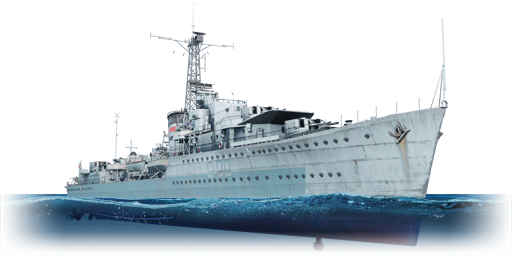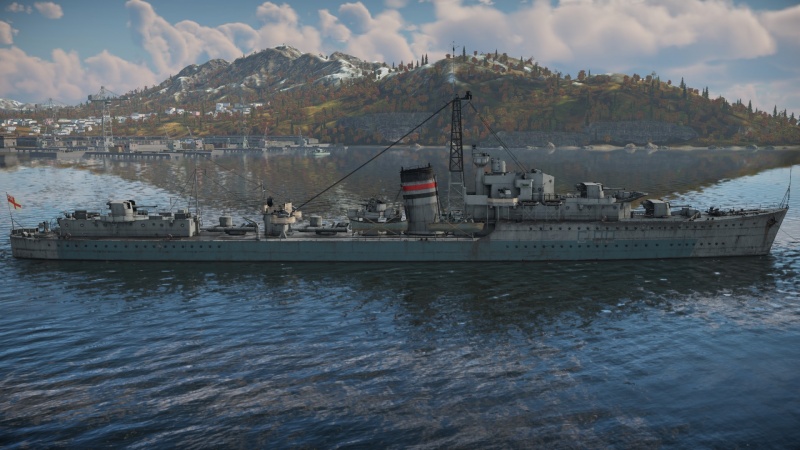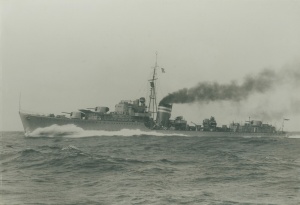Difference between revisions of "HMS Jervis"
m |
|||
| Line 16: | Line 16: | ||
The Jervis' protection is practically nonexistent. She only had 3.2 mm of casemate armour to protect her main guns, and her Oeklion autocannons mount ironically had thicker (but still bad) gun shield of 12.7 mm in thickness. Simply put, the Jervis will took full damage from any of the large cannon caliburs, and even small autocannons can pose a threat to her survival. | The Jervis' protection is practically nonexistent. She only had 3.2 mm of casemate armour to protect her main guns, and her Oeklion autocannons mount ironically had thicker (but still bad) gun shield of 12.7 mm in thickness. Simply put, the Jervis will took full damage from any of the large cannon caliburs, and even small autocannons can pose a threat to her survival. | ||
| − | To make the matter worse, almost every vital part of the Jervis is exposed | + | To make the matter worse, almost every vital part of the Jervis is exposed to enemy fire to an extent, her engines and transmissions is sitting above the waterline with no fuel tank to absorb the incoming shot, and thus easy to knock out. Her ready ammo racks is a fatal weakspot, as it is placed just nearby the main turrets. Any HE shells that were detonating around her turrets is most likely to detonate them, causing severe damage to the ship. |
=== Mobility === | === Mobility === | ||
{{Specs-Fleet-Mobility}} | {{Specs-Fleet-Mobility}} | ||
Revision as of 21:02, 15 October 2021
Contents
Description
The J-class, HMS Jervis (F00), 1944 is a premium rank II British destroyer with a battle rating of 4.3 (AB/RB/SB). It was introduced in Update "New Power".
General info
Survivability and armour
In real life, the Jervis is famous for never took any single crew loss during her extensive career in World War II despite occasionally took serious damage. In War Thunder, however, the "Lucky J" does not have her immense luck to save her crew from incoming fire.
The Jervis' protection is practically nonexistent. She only had 3.2 mm of casemate armour to protect her main guns, and her Oeklion autocannons mount ironically had thicker (but still bad) gun shield of 12.7 mm in thickness. Simply put, the Jervis will took full damage from any of the large cannon caliburs, and even small autocannons can pose a threat to her survival.
To make the matter worse, almost every vital part of the Jervis is exposed to enemy fire to an extent, her engines and transmissions is sitting above the waterline with no fuel tank to absorb the incoming shot, and thus easy to knock out. Her ready ammo racks is a fatal weakspot, as it is placed just nearby the main turrets. Any HE shells that were detonating around her turrets is most likely to detonate them, causing severe damage to the ship.
Mobility
Being a destroyer with relatively low displacement, the Jervis is very fast and maoverable. Due to her very poor protection, using her mobility is a key to survive.
| Mobility Characteristics | |||
|---|---|---|---|
| Game Mode | Upgrade Status | Maximum Speed (km/h) | |
| Forward | Reverse | ||
| AB | |||
| Upgraded | 85 | 31 | |
| RB/SB | |||
| Upgraded | 69 | 25 | |
Modifications and economy
Armament
Primary armament
The Jervis is equipped with six 120 mm Mk.XII cannons, mounted in three twin turrets in A-Bs-X setup. These guns have very good traverse speed, and the placement of the turrets allowing the B and X turrets to completely turn around, which will comes into handy when using it with quick turning to avoid incoming shots.
The 120 mm guns have a fast reload of 5 seconds (ace crew) and features four types of ammuniton; HE, SAP, HE-TF, and HE-VT. The HE shell is reliable against destroyers and some light cruisers. While SAP shell is only useful for dealing internal damage at close range due to poor penetration. As the turrets has fast traverse speed and good coverage, anti-air shells will be useful for engaging enemy planes at range if you wish to.
Anti-aircraft armament
The Jervis features 4 x 40 mm Pom-pom autocannons and 10 x 20 mm Oerlikon autocannons being grouped together as an anti-aircraft armament, which is unique among the British destroyers, as the Pom-pom autocannons on them were usually classed as "secondary armament" and controlled separately from AA suite. This unique grouping allows her captain to control all of these guns at once and concentrate fire on enemy aircraft and PT boat more efficently.
Additional armament
The Jervis is loaded with 8 x 533 mm Mk.IX torpedoes. These torpedoes had 340 kg of TNT warhead, which is good enough to tackle most targets the Jervis will face. The torpedoes, however, had a relatively poor top speed of 67 km/h without torpedo mode, and only 56 km/h with torpedo mode modification. As the torpedo have a maximum range of 9.6 km which is within the range that the Jervis will usually engage, and the torpedo mode modification only adds 3 km of extra range, it is advised to uninstall these modification to increase the torpedo's effectiveness.
Usage in battles
The Jervis is essentially a glass cannon that is good at delivering damage but bad at taking it. Due to her abysmal protection, rushing into the enemy or trading shots with them is essentially a suicide, as most of your critical modules can be quickly taken out before you can take your enemy down. Instead, play as a support ship and stay behind your ally, your guns and torpedoes is a great asset for taking down destroyers and harrassing enemy cruisers, and your anti-air defense will keep any of the inbound aircraft or PT boats at bay. In Jervis shouldn't travel in a straight line for too long as the enemy will target you, instead using your good mobility and turret traverse speed to avoid incoming fire and do a quick snapshot at them.
Pros and cons
Pros:
- Fast-firing 120 mm cannons with very good coverage
- Good turret traverse speed, the B and X turrets are fully traverseable
- Very fast and manoverable
- Good anti-air armaments
- Good torpedoes with decent range
Cons:
- Extremely poor protection
- All of the internal modules can be easily damaged
- Very low crew count
- Turrets is easy to knocked out
- Ready ammo racks is exposed to enemy fire and can be detonated
History
HMS Jervis, J-class Flotilla Leader was a destroyer of the J class. Commissioned just before the outbreak of war, Jervis saw extensive service in the Mediterranean and Atlantic theatres. She participated in multiple major engagements in the Mediterranean, and later participated in the D-Day landings of 1944. Jervis was retired at the end of the war, and later scrapped. She was highly decorated and received 13 battle honours for her service in the Second World War. Jervis also gained a reputation for being extremely lucky, as she never lost a single crew member during her 5 and a half years of service.[1][2]
Design and Development
The Jervis, as a member of the J class, was designed as a smaller follow-up to the preceding Tribal-class destroyers. Being smaller, the J class had a stronger balance between guns and torpedo armament, compared to the "gunship-style" Tribal-class destroyers. Jervis, in particular, was fitted with additional command space to accommodate the Flotilla commander. Jervis displaced 2600 tons, and was capable of 36 knots (66 km/h).[1] Her main armament consisted of six 4.7-inch (120 mm) guns in three dual turrets, two mounted at the bow and one at the stern.[1] She also carried numerous anti-aircraft defences as well as eight 533 mm torpedo tubes in two quad-mounts.[1]
Jervis was laid down in mid-1937 and was launched in September of 1938. She was completed and commissioned in May of 1939, just months before the outbreak of the Second World War.
Service history
Following her completion and commissioning, the Jervis served as the flagship of the 7th Destroyer fleet. She first served as a patrol vessel in the North Sea, hunting for axis blockade runners; however, she collided with a freighter in March of 1940 and was dry docked for repairs.[2] Once the repairs were completed, she was assigned to the Mediterranean squadron, where she saw extensive service. She escorted convoys to Malta, participated in shore bombardment missions, and provided screening services to the British Mediterranean fleet.[2]
In 1941, Jervis served in the Battle of Cape Matapan, where she sank the crippled Italian cruiser Zara and boarded Zara's sister ship Pola. She later participated in the battles of Crete and Sirte, where she managed to survive undamaged despite heavy allied losses.[2] Later on, she was immobilized for six weeks by an Italian manned torpedo.[1][2]
In 1944, Jervis was reassigned to the British Atlantic fleet, and provided fire support for the forces landing at Gold Beach for the D-Day landings. She was thereafter decommissioned for a refit which gave her additional anti-aircraft protection.[2] She returned to the Mediterranean after her recommissioning, and served as a patrol ship as World War II drew to a close. Following the end of the war, she was laid up in reserve and used by the cadets as a training ship. After being used for explosive tests, Jervis was given to the shipbreakers for scrap.[2]
Jervis is known as an extremely lucky ship: despite being active for almost the entirety of the war and having served in 13 major naval engagements, she never lost a single crew member.[1] In fact, she was one of just two J-class ships to survive the war. She received 13 battle honours for her service during the Second World War, making her one of the most highly decorated British warships in modern history.[1][2]
Media
Excellent additions to the article would be video guides, screenshots from the game, and photos.
See also
Links to articles on the War Thunder Wiki that you think will be useful for the reader, for example:
- reference to the series of the ship;
- links to approximate analogues of other nations and research trees.
External links
Citations
Bibliography
- D-Day Encyclopedia. (2020). HMS Jervis - F00 - D-Day. Retrieved November 28, 2020, from https://www.dday-overlord.com/en/material/warships/hms-jervis
- Smith, G. (2004). HMS Jervis, Destroyer. Retrieved November 28, 2020, from http://www.naval-history.net/xGM-Chrono-10DD-36J-JervisJERVIS%201a.htm
| Britain destroyers | |
|---|---|
| Town-class | HMS Churchill · HMS Montgomery |
| V-class | HMS Valhalla · HMS Vega · HMS Verdun |
| G-class | HMS Grafton · ORP Garland |
| Hunt-class | HMS Calpe · HMS Brissenden |
| Tribal-class | HMCS Haida · HMS Eskimo · HMS Mohawk |
| J-class | HMS Jervis |
| K-class | HMS Kelvin |
| N-class | HMAS Nepal |
| Battle-class | HMS Armada · HMS Cadiz · HMAS Tobruk |
| Daring-class | HMS Daring · HMS Diamond · HMS Diana |
| Britain premium ships | |
|---|---|
| Motor torpedo boats | MTB-1(2) · MTB-422 · Fairmile D (5001) · HMS Gay Archer |
| Motor gun boats | MGB-75 · SGB Grey Goose |
| Gunboats | HMS Spey |
| Sub-chasers | LÉ Orla |
| Frigates | HMS Whitby |
| Destroyers | HMS Montgomery · HMS Valhalla · HMS Verdun · ORP Garland · HMS Jervis · HMCS Haida · HMS Mohawk · HMS Cadiz · HMS Diamond |
| Light cruisers | HMS Belfast |
| Battleships | HMS Iron Duke |






